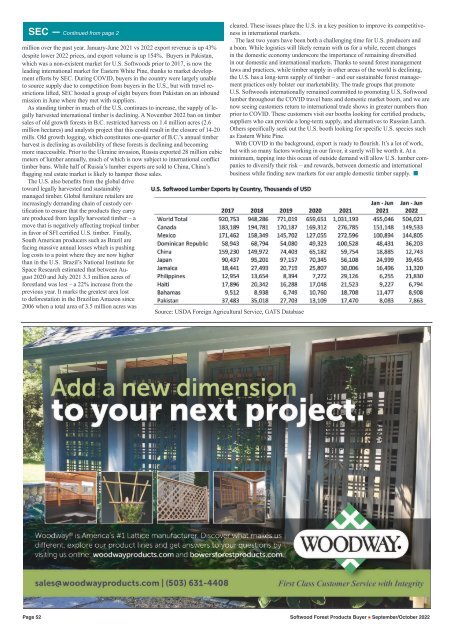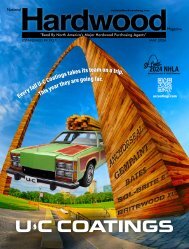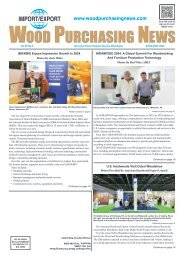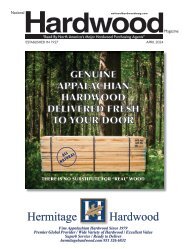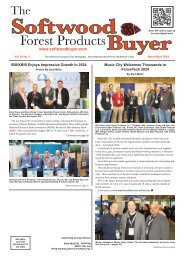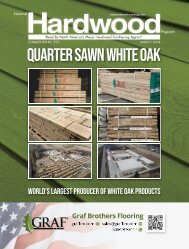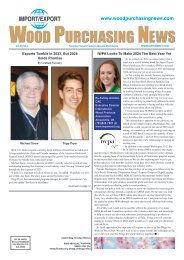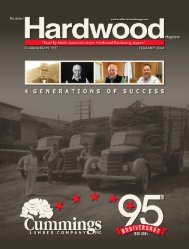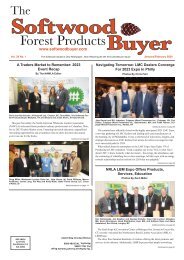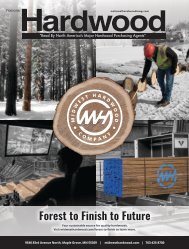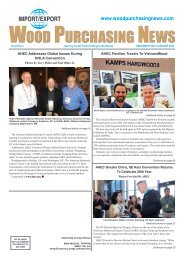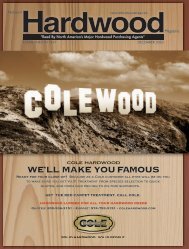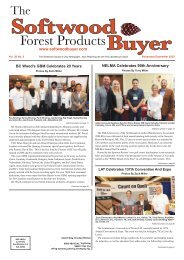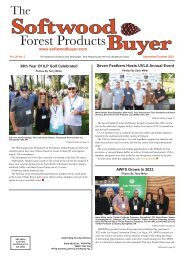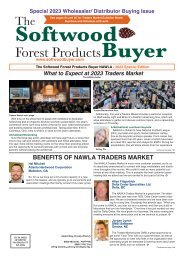The Softwood Forest Products Buyer - September/October 2022
The latest issue of the Softwood Forest Products Buyer features stories on the NAWLA Portland Regional Meeting, Atlanta Hardwood Corp, Holt & Bugbee and so much more.
The latest issue of the Softwood Forest Products Buyer features stories on the NAWLA Portland Regional Meeting, Atlanta Hardwood Corp, Holt & Bugbee and so much more.
Create successful ePaper yourself
Turn your PDF publications into a flip-book with our unique Google optimized e-Paper software.
SEC — Continued from page 2<br />
million over the past year. January-June 2021 vs <strong>2022</strong> export revenue is up 43%<br />
despite lower <strong>2022</strong> prices, and export volume is up 154%. <strong>Buyer</strong>s in Pakistan,<br />
which was a non-existent market for U.S. <strong>Softwood</strong>s prior to 2017, is now the<br />
leading international market for Eastern White Pine, thanks to market development<br />
efforts by SEC. During COVID, buyers in the country were largely unable<br />
to source supply due to competition from buyers in the U.S., but with travel restrictions<br />
lifted, SEC hosted a group of eight buyers from Pakistan on an inbound<br />
mission in June where they met with suppliers.<br />
As standing timber in much of the U.S. continues to increase, the supply of legally<br />
harvested international timber is declining. A November <strong>2022</strong> ban on timber<br />
sales of old growth forests in B.C. restricted harvests on 1.4 million acres (2.6<br />
million hectares) and analysts project that this could result in the closure of 14-20<br />
mills. Old growth logging, which constitutes one-quarter of B.C.’s annual timber<br />
harvest is declining as availability of these forests is declining and becoming<br />
more inaccessible. Prior to the Ukraine invasion, Russia exported 28 million cubic<br />
meters of lumber annually, much of which is now subject to international conflict<br />
timber bans. While half of Russia’s lumber exports are sold to China, China’s<br />
flagging real estate market is likely to hamper those sales.<br />
<strong>The</strong> U.S. also benefits from the global drive<br />
toward legally harvested and sustainably<br />
managed timber. Global furniture retailers are<br />
increasingly demanding chain of custody certification<br />
to ensure that the products they carry<br />
are produced from legally harvested timber – a<br />
move that is negatively affecting tropical timber<br />
in favor of SFI certified U.S. timber. Finally,<br />
South American producers such as Brazil are<br />
facing massive annual losses which is pushing<br />
log costs to a point where they are now higher<br />
than in the U.S. Brazil’s National Institute for<br />
Space Research estimated that between August<br />
2020 and July 2021 3.3 million acres of<br />
forestland was lost – a 22% increase from the<br />
previous year. It marks the greatest area lost<br />
to deforestation in the Brazilian Amazon since<br />
2006 when a total area of 3.5 million acres was<br />
cleared. <strong>The</strong>se issues place the U.S. in a key position to improve its competitiveness<br />
in international markets.<br />
<strong>The</strong> last two years have been both a challenging time for U.S. producers and<br />
a boon. While logistics will likely remain with us for a while, recent changes<br />
in the domestic economy underscore the importance of remaining diversified<br />
in our domestic and international markets. Thanks to sound forest management<br />
laws and practices, while timber supply in other areas of the world is declining,<br />
the U.S. has a long-term supply of timber – and our sustainable forest management<br />
practices only bolster our marketability. <strong>The</strong> trade groups that promote<br />
U.S. <strong>Softwood</strong>s internationally remained committed to promoting U.S, <strong>Softwood</strong><br />
lumber throughout the COVID travel bans and domestic market boom, and we are<br />
now seeing customers return to international trade shows in greater numbers than<br />
prior to COVID. <strong>The</strong>se customers visit our booths looking for certified products,<br />
suppliers who can provide a long-term supply, and alternatives to Russian Larch.<br />
Others specifically seek out the U.S. booth looking for specific U.S. species such<br />
as Eastern White Pine.<br />
With COVID in the background, export is ready to flourish. It’s a lot of work,<br />
but with so many factors working in our favor, it surely will be worth it. At a<br />
minimum, tapping into this ocean of outside demand will allow U.S. lumber companies<br />
to diversify their risk – and rewards, between domestic and international<br />
business while finding new markets for our ample domestic timber supply. n<br />
Source: USDA Foreign Agricultural Service, GATS Database<br />
WRCLA— Continued from page 7<br />
sage seeded.” <strong>The</strong> course focuses mainly on WRC siding, including soffits and<br />
trim, as it plays such a major role in the design and style of a home or building as<br />
well as protecting it from the elements. <strong>The</strong> course also points out that although<br />
the siding category has had a myriad of competitive man-made substitute products<br />
that have appeared and disappeared over the decades, WRC siding has been a<br />
popular constant for hundreds of years.<br />
“We know that professionals and homeowners alike are genuinely surprised<br />
when they learn that they literally have hundreds of options when it comes to<br />
specifying finishes for siding and trim,” said Kirkbride. “Add in the different<br />
textures, profiles and grades and you can create whatever design you want.” <strong>The</strong><br />
CEU covers the first and most simple non-maintenance option of leaving WRC<br />
siding unfinished so it naturally turns gray over time. This option also has the advantage<br />
of having the most benign environmental impact of all alternative product<br />
choices for similar building applications, according to a recent third-party Life<br />
Cycle Assessment of natural Western Red Cedar siding and decking.<br />
As the majority of Western Red Cedar users will prefer a finish that preserves<br />
the wood’s natural color and appearance, the range of natural finishes such as<br />
transparent and semi-transparent stains is also explained. One technique that<br />
is gaining in popularity is the use of bleaching and weathering products. <strong>The</strong>se<br />
are essentially water-repellent finishes containing pigments and other additives.<br />
Bleaching stains accelerate the weathered, gray look faster and more evenly than<br />
if the wood was left to naturally weather. After bleaching, the Western Red Cedar<br />
can be left in its natural state or given a coat of clear sealer.<br />
Included in the variety of finishing options available are opaque finishes; used<br />
with finger-joint products or in cases where the color and natural grain of the<br />
wood are not required, and the waxes and coatings used in interior applications.<br />
<strong>The</strong> importance of using WRC products to mitigate climate change and the versatility<br />
they offer are but two of the benefits that contribute to upselling Western<br />
Red Cedar’s true value to the customer. <strong>The</strong> emerging area of biophilic design,<br />
in which studies are showing that incorporating natural products like wood in<br />
interior and exterior design have positive health benefits and help reduce stressrelated<br />
illnesses, also resonates strongly with consumers and further differentiates<br />
WRC from composite competitors.<br />
By adhering to a consistent message and focusing on the value of their products,<br />
the WRCLA is avoiding bombarding potential customers with meaningless<br />
messages and instead are working to stand out from their competitors and create<br />
long-term, happy customers by providing more value than anyone else. n<br />
WHO’S WHO - Haddix Continued from page 2<br />
in inside sales, special projects, and various informal leadership roles. In the summer<br />
of 2021, she was promoted to Operations and revels in the variety of her new<br />
position.<br />
Asked to describe one of her favorite things about working at PLC, Haddix<br />
said “Our customer service is second to none. Our goal is to help clients solve<br />
problems and we work hard – as a team – to get the job done.”<br />
Patrick Lumber Co. is a member of the North American Wholesale Lumber<br />
Association, Portland Wholesale Lumber Association, National Wood Flooring<br />
Association, National Hardwood Lumber Association, and Hoo-Hoo International.<br />
Terry is active in several of these organizations – she is currently the Vice<br />
President of the PWLA, and a member of the NAWLA Education Committee, as<br />
well as a past President and current Supreme 9 in HHI.<br />
Haddix graduated high school in Eatonville, WA and attended the ubiquitous<br />
“School of Hard (lumber) Knocks.” She and her husband of 21 years, Bryan,<br />
have a son and a daughter. Together, the couple are on the leadership team of an<br />
organization that provides summer camp experiences to kids in the foster system.<br />
Terry is also in the Rose Festival Clown Corps, where she has led groups of local<br />
tradeswomen as they represent Rosie the Riveter in Rose Festival parades. She<br />
is a proud dragon boater, and enjoys cake and cookie decorating. During the<br />
pandemic, Terry discovered a new love for puzzles, and has recently decided to<br />
go back to school to earn a degree in management.<br />
Located in Portland, OR, Patrick Lumber Co. is a global wholesaler and<br />
remanufacturer that sells its lumber products internationally. <strong>The</strong> company offers<br />
rough lumber, boards, patterns and timbers including high end, appearance-grade<br />
Douglas Fir, Western Red Cedar, Hemlock, SYP, and AYC. •<br />
For more information, Terry can be contacted at terryh@patlbr.com or<br />
(503) 805-9899.<br />
LIKE US ON<br />
@MillerWoodTradePublications<br />
www.millerwoodtradepub.com<br />
Page 52 <strong>Softwood</strong> <strong>Forest</strong> <strong>Products</strong> <strong>Buyer</strong> • <strong>September</strong>/<strong>October</strong> <strong>2022</strong> <strong>Softwood</strong> <strong>Forest</strong> <strong>Products</strong> <strong>Buyer</strong> • <strong>September</strong>/<strong>October</strong> <strong>2022</strong> Page 53


